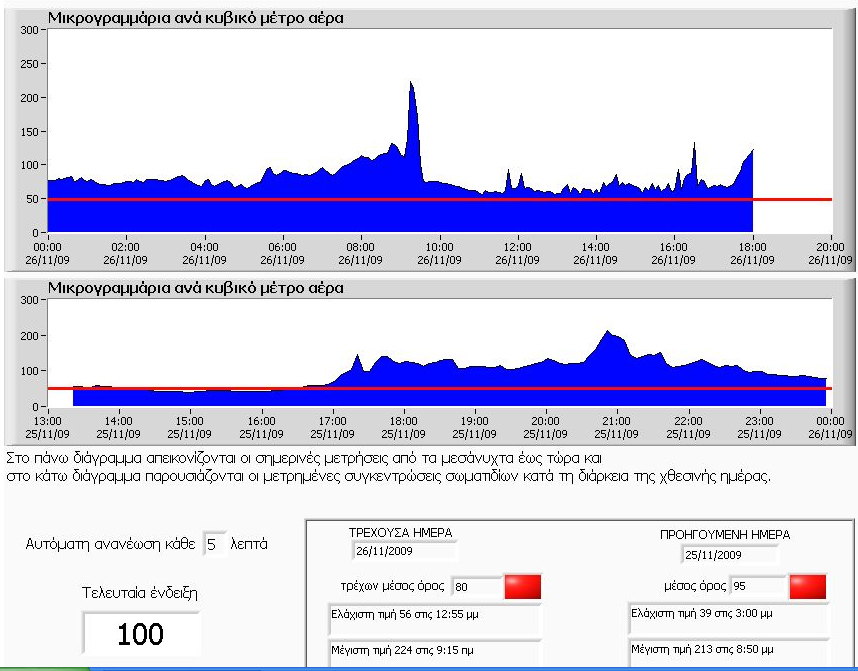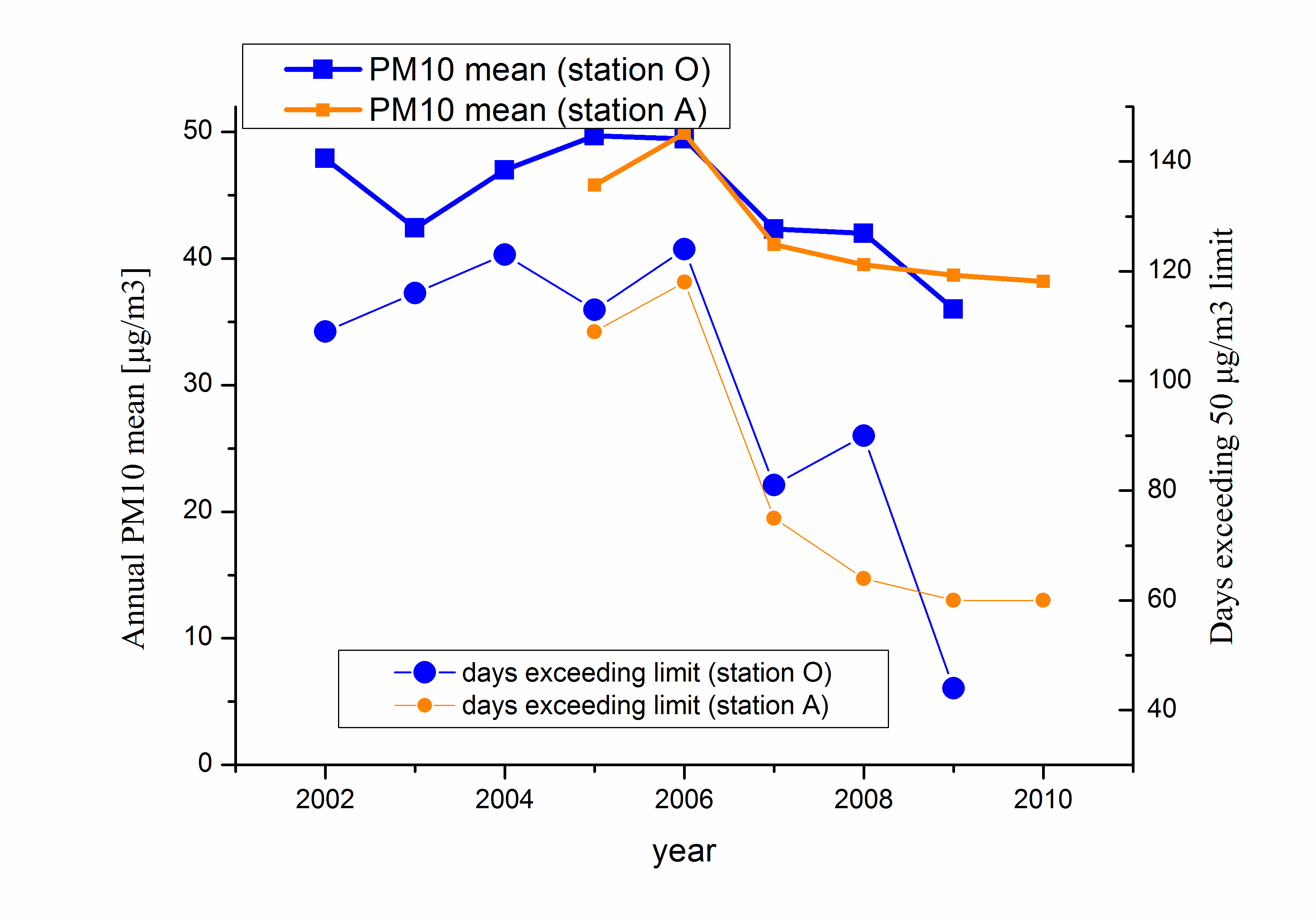-
Paper Information
- Next Paper
- Previous Paper
- Paper Submission
-
Journal Information
- About This Journal
- Editorial Board
- Current Issue
- Archive
- Author Guidelines
- Contact Us
American Journal of Environmental Engineering
p-ISSN: 2166-4633 e-ISSN: 2166-465X
2012; 2(4): 97-108
doi: 10.5923/j.ajee.20120204.05
Analysis of Data From Ambient PM10 Concentration Monitoring in Volos in the Period 2005-2010
Zogou O. , A. Stamatelos
Mechanical Engineering Department, University of Thessaly, Volos, Greece
Correspondence to: A. Stamatelos , Mechanical Engineering Department, University of Thessaly, Volos, Greece.
| Email: |  |
Copyright © 2012 Scientific & Academic Publishing. All Rights Reserved.
This paper presents the results of a monitoring campaign for ambient PM10 concentrations in Volos, Greece in the period 2005-2010. The aim is to give an overview of the evolution of particulate pollution, discuss effects of the micro-climate and demonstrate that PM10 monitoring may be carried out with low-cost measurement instruments at a community level. Statistical processing of the 2009-2010 measurement data indicates a negative correlation of PM10 with ambient air temperature and a positive correlation with relative humidity. Low PM10 concentrations are associated with E to SE winds and high concentrations with NW to N winds. Daily variation of particulate matter concentrations follows well established patterns with peaks at 09:00-10:00 and 23:00-24:00. The operation of an expanded PM10 monitoring network is under way.
Keywords: Particulate Matter, PM10 Monitoring, Air Quality, Statistical Analysis
Article Outline
1. Introduction
- Major Greek cities are suffering from increased particulate emissions levels[1-4]. Volos is no exception to this fact. The city is neighboring with an important industrial area to the West and a cement factory to the East. It has a moderate traffic problem in the city center and an active commercial harbor in the southern part. It is bounded by Mount Pelion to the North. Amospheric inversion episodes are not uncommon. Since the year 2001, a significant effort has been made by the Greek Government to enhance air quality monitoring in major urban areas. A network of 28 stations was installed in 2001, mainly in Athens and Thessaloniki[4]. Volos was equipped with one monitoring station (Station O in Figure 1). The measurement of PM10 in the specific family of stations is carried out by means of beta attenuation mass measurement instruments[5]. By the year 2011, Volos’ station has already completed 10 years of operation and suffers from maintenance problems. Thus, the management of particulate emissions from urban traffic, industrial activity and garbage burns in the greater urban area is limited by inexact knowledge of particulate movement and dispersal in the area as a whole, and on medium and small-topographic scales in particular.
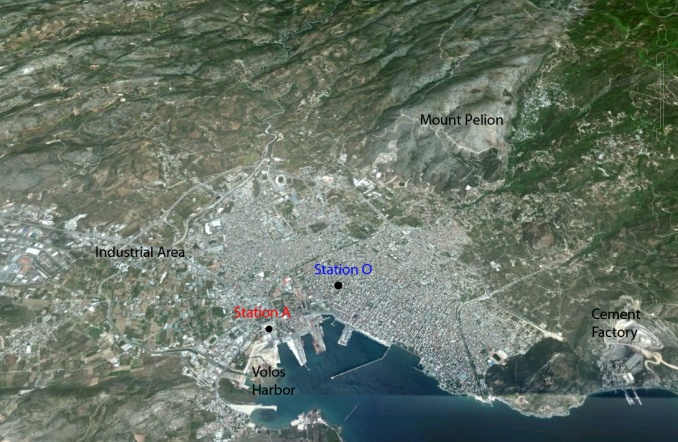 | Figure 1. Location of the monitoring station A at the University Campus at Pedion Areos, and the official monitoring station O at the center of Volos |
 | Figure 3. Typical structure of a monthly PM10 bulletin as published in the website (October 2008). Hourly PM10 means for the 24 hours of the respective day are presented in each column |
2. Measurement Instruments and Monitoring System
- Based on an initial instrument survey, it was realized that a continuous reference instrument, such as a Tapered Element Oscillating Microbalance (TEOM) or Beta Attenuation Mass measurement (BAM) instrument, would be likely to require a substantial expenditure on supporting infrastructure (e.g. air conditioned enclosure etc), and significant power and maintenance resources, while providing only hourly time resolution[9]. In contrast, previous experience with an optical particle counter (TSI 8520 DustTrak) had shown that a relatively low-cost instrument could give a very good proxy measurement of PM10. This is confirmed by experience from other researchers[10, 11]. In order for the station and the future network to operate successfully, it was considered necessary to be equipped with an air quality instrument capable of continuous measurement, (preferably subhourly time resolution). The equipment had to be securely housed and to require only basic maintenance to operate under automatic control for long intervals. Low total power consumption and a small footprint were considered significant advantages. The overall cost needed to be as low as possible.Data collected with such an optical instrument are not mass measurements, but are a proxy based on a measured particle count and a calibration from counts to mass for the particular aerosol under study. Optical particle counters tend to be more sensitive to smaller particle, due to the nature of light scattering from aerosols[12]. Several optical particle counters are commercially available[9]. Dusttrak II 8530[7] is a network enabled device, providing a simple and direct means of communicating with the instrument remotely. The instrument provides estimates of PM1, PM2.5, PM4, and PM10, depending on which diffuser is inserted. The device can be field calibrated by the operator.One possible confounding signal that arises when using optical scattering methods is the presence of high-humidity in the sample air, with the most extreme case being fog. Scatter from water droplets can mimic that from smoke or other aerosols, hence optical measurements taken under these conditions can overestimate the true PM signal[13]. Early experience with the model 8520 DustTrak showed this effect. The Beta Attenuation Mass Measurement instruments are also sensitive to relative humidity. To overcome this effect, the air being passed to the instrument can be preheated by drawing the sample air through a heated tube. A suitable meteorological station was also required. A variety of such stations are commercially available, with a corresponding wide range of costs. While there were advantages in using a ‘high-end’ meteorological station, it was decided that, given the air quality data would be ‘indicative’ rather than reference-quality data, there were significant cost advantages in selecting a basic meteorological installation. The Global Water GL400 data-logging weather station was chosen after a comparison of available systems. Labview was used to provide on-board data storage and network IP communications.Network communications to the station was an issue of active consideration. The older model Dusttrak 8520 was communicating with a networked PC via serial port. The more recent model Dusttrak II 8530 is equipped with an Ethernet communication (LAN) port. The instrument is given a fixed IP address within the University firewall.The inlet of the sample line exits the station wall at a height of 3m from ground, and is turned in a gentle curve to point downwards. It is protected from insects’ ingress by a fine wire mesh.Labview was employed for communication, data reporting and analysis, and web publication. A custom made code is written to this purpose. Communication with the instrument at a given station is via calls to an internet SOCKET command[8]. The code routinely polls one or more stations and receives second-by-second readings from the Dusttrak instruments. Also, it receives recordings from the meteorological station, via serial port communication. The PC running the program is located in the main station A, connected by serial communications cable to the met station. All data from the network are retrieved via this PC. Labview also provides the tool for creating the graphical user interface for the web publishing. Data from the Dusttrak and meteorological instruments are written to a daily file. A plot of these data is generated and displayed on the data-logging PC. The plot files are also written to the server disk after each data read, and copied to a web server for public viewing.More details on the comparative performance of the two types of instruments are presented in a subsequent section. As regards the quality assurance of the collected data, the following basic steps are taken (see for example[14]):● Elimination of outliers in the measured data (unmeasured values, erroneous values, negative values etc), caused by instantaneous failure of the instrument or data logging system. The missing values are substituted by values interpolated from neighboring values.● Basic FFT analysis of the measurement signals, to bring into the foreground the most important periodicities in each measured variable. Again, the existence of very high frequencies in immisions points to instrument or data logging failure, or the presence of temporary sources of local nature in the vicinity of the station. Such sources may damage the quality of the measured data sets.● Signal filtering by low pass finite impulse response (FIR) filters that eliminates the above-mentioned noise and leads to smoother measured data time series.Following the processing of data by the above methodology, we now proceed to the presentation of final, corrected data time series and their basic statistics.
3. Overview of the Measurement Data
- The adoption of the new Directive 2008/50/EC[15] on ambient air quality and cleaner air for Europe signals the merging of most of existing legislation into a single directive (except for the fourth daughter directive) with no change to existing air quality objectives. Thus, the limit of 35 days of exceeding the 50 μg/m3 threshold in PM10 from the previous Directive 1999/30/EC[16] remains in force, along with the 40 μg/m3 limit in the annual PM10 mean value. In addition, new air quality objectives are introduced for PM2.5 (fine particles) including the limit value and exposure related objectives – exposure concentration obligation and exposure reduction target. Also, it introduces the possibility to discount natural sources of pollution when assessing compliance against limit values. A possibility for time extensions of three years for PM10 for complying with limit values is also included, based on conditions and the assessment by the European Commission. More stringent requirements including a 28 μg/m3 limit in the annual PM10 mean value and a 24-hour limit of 35 μg/m3 not to be exceeded more than 35 days annually are introduced starting 2010.The evolution of annual PM10 levels and number of days exceeding the 50 μg/m3 threshold, as measured by the two monitoring stations of Figure 1, are presented in Figure 4 for the period 2002-2010. The following remarks can be made here:High levels of yearly average ambient PM10 concentrations, significantly exceeding the 40 μg/m3 limit of the directive, persisted in Volos in the period 2002 to 2006. These high PM10 levels were accompanied with a large number of days exceeding the 50 μg/m3 threshold – more than 100 days each year[17].
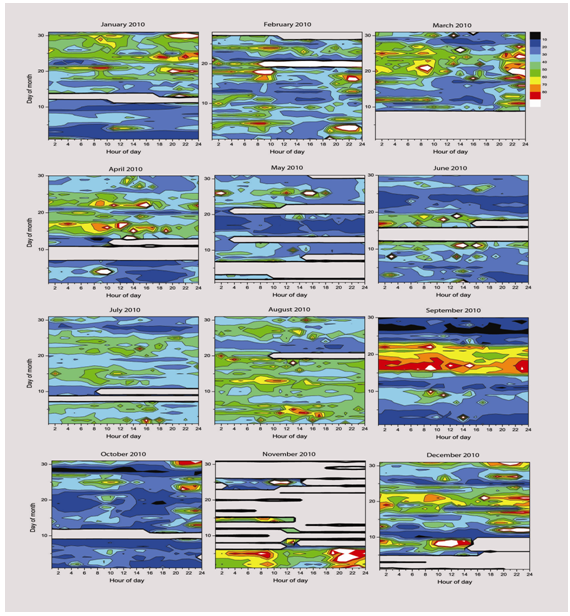 | Figure 5. Summary of station A hourly measurements during the 12 months of 2010 in Volos. Grey areas indicate lack of data due to instrument problem. White areas denote PM10 values exceeding 90 μg/m3 |
4. Comparisons of Recordings from Two Different Instruments
- As already mentioned, there exists one further issue with PM10 monitoring, where the statistical analysis may ensure favorable conditions for the exploitation of low-cost measuring equipment, to give a very good indicative (proxy) measurement of PM10. Correlation of recordings from the two different instruments, adding to the experience from the study and statistical analysis of recordings from the Dusttrak and beta attenuation instruments has already been reported by other researchers[19].A comparison of the recordings from the Dusttrak 8520 instruments in station A to those of the beta attenuation instrument in station O may give us useful information, although the two instruments have different operation principles, and their locations are at a distance of about 1 km (see Figure 1).During the period 2005-2008 the 24-hour averages of the two monitoring stations generally show a good overall agreement as seen in the example of Figure 6 (May 2008). Obviously, the 24-hour means agree to a certain degree. To a good approximation, the proxy PM10 values, derived from the 24-hour-averaged DustTrak reading, gives a reliable measure of PM10. These data were in fact used in 2005 to check the calibration of the DustTrak 8520 instrument, based on the data from the beta attenuation measurement instrument. Of course, the two stations are in different locations, so they are not expected to give similar results on an hourly basis. Anyway, it would be interesting to compare the transient recordings from the two stations. This is shown in the comparison between recordings of Stations O and A in Figure 7, where data from both stations for the period May 2008 are shown. A qualitative agreement is only observed in this case.
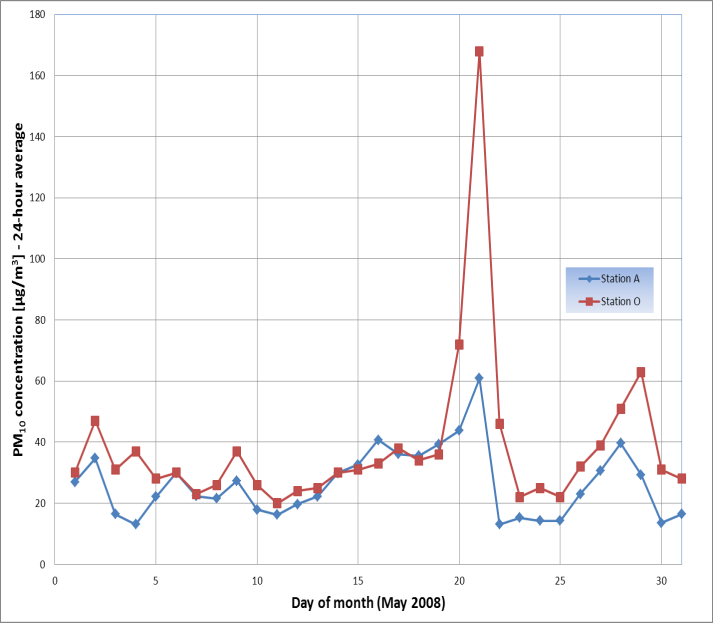 | Figure 6. Comparison between 24-h average PM10 concentrations recorded at station A (Dusttrak 8520) and station O (beta attenuation instrument) recordings during May 2008 |
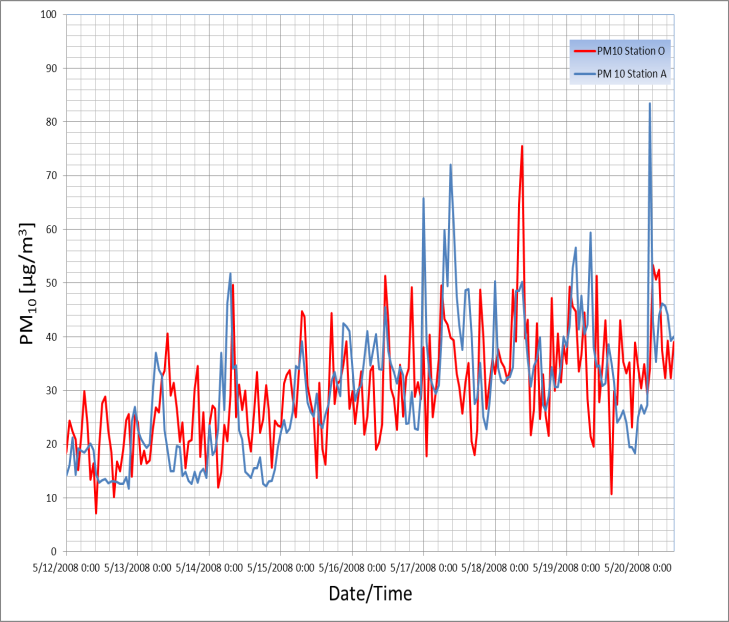 | Figure 7. Comparison of hourly PM10 recordings of Dusttrak 8520 in station A to recordings from the beta attenuation instrument in station O location, during the period 12-20 May 2008 |
5. Correlation of PM10 Concentration with Meteorological Conditions
- Having confirmed a good correlation of the readings from the two stations, we proceed to investigate the effect of the following meteorological data to the PM10 levels:Wind direction, wind speed, ambient dry-bulb temperature, absolute and relative humidity.As a starting point, it is interesting to observe the evolution of meteorological conditions and PM10 emissions in station A during one full week of May 2010, as presented in Figure 8. The specific week was selected to be free from significant activity of residential heating equipment in the city. A number of interesting remarks can be made here:
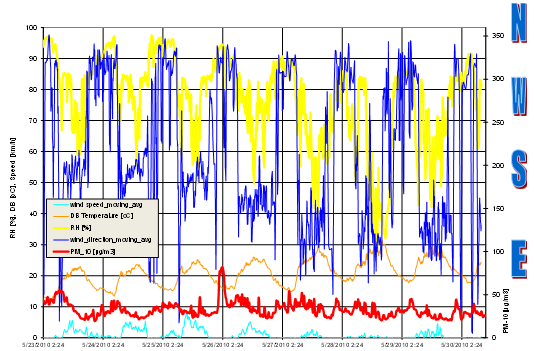 | Figure 8. Evolution of meteorological conditions and PM10 emissions in station A during one full week of May 2010 |
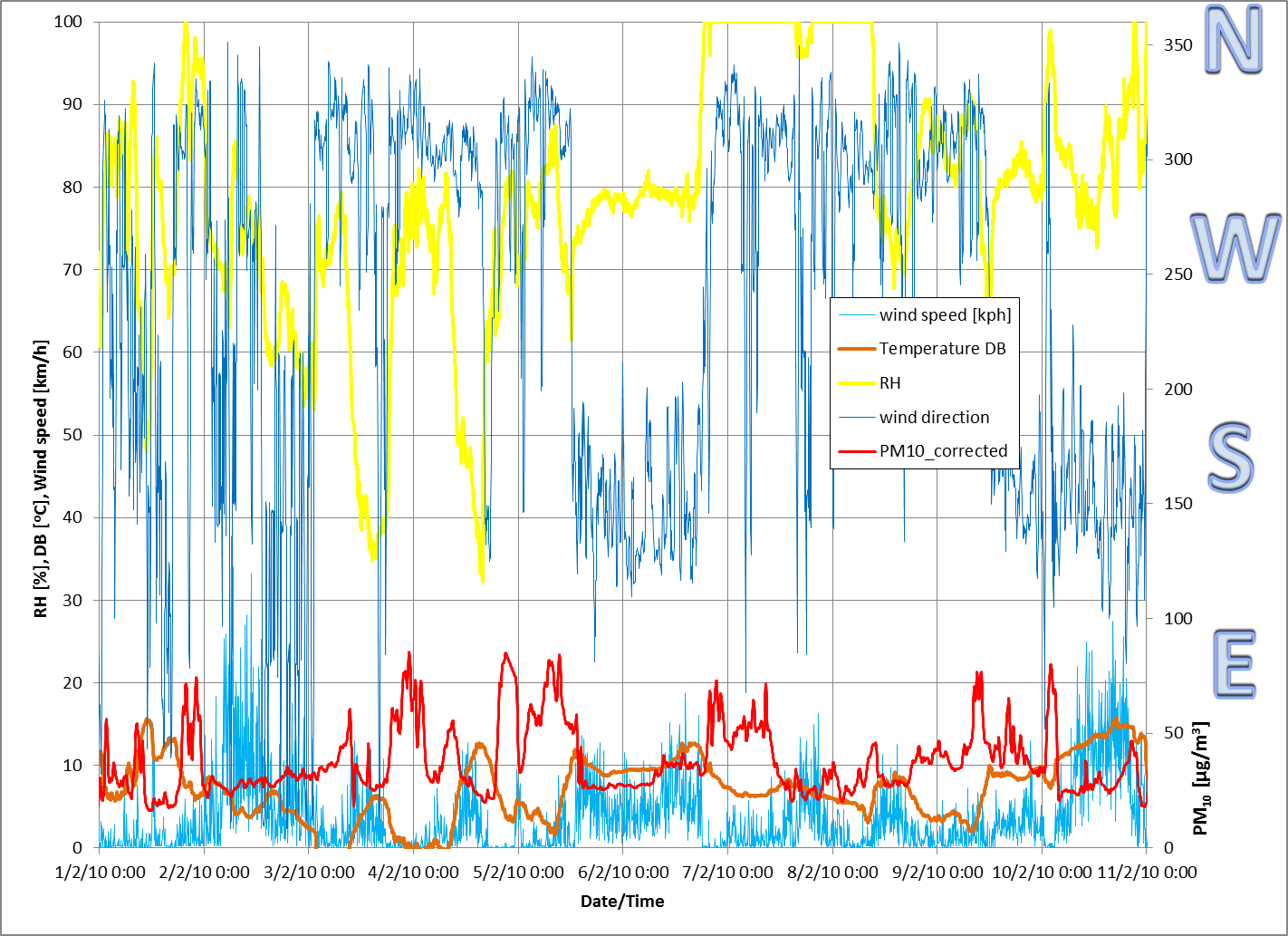 | Figure 9. Meteorological conditions and PM10 emissions in station A during 11 days of February, 2010 |
5.1. Effect of the Hour of day
- A one-way ANOVA applied to the hourly PM10 values of the year 2010, versus the variable “hour of day” gives the results presented in Table 2.As expected from everyday experience, the PM10 concentrations are dependent on the hour of day with a good reliability (F=81) and Significance = 0.000.
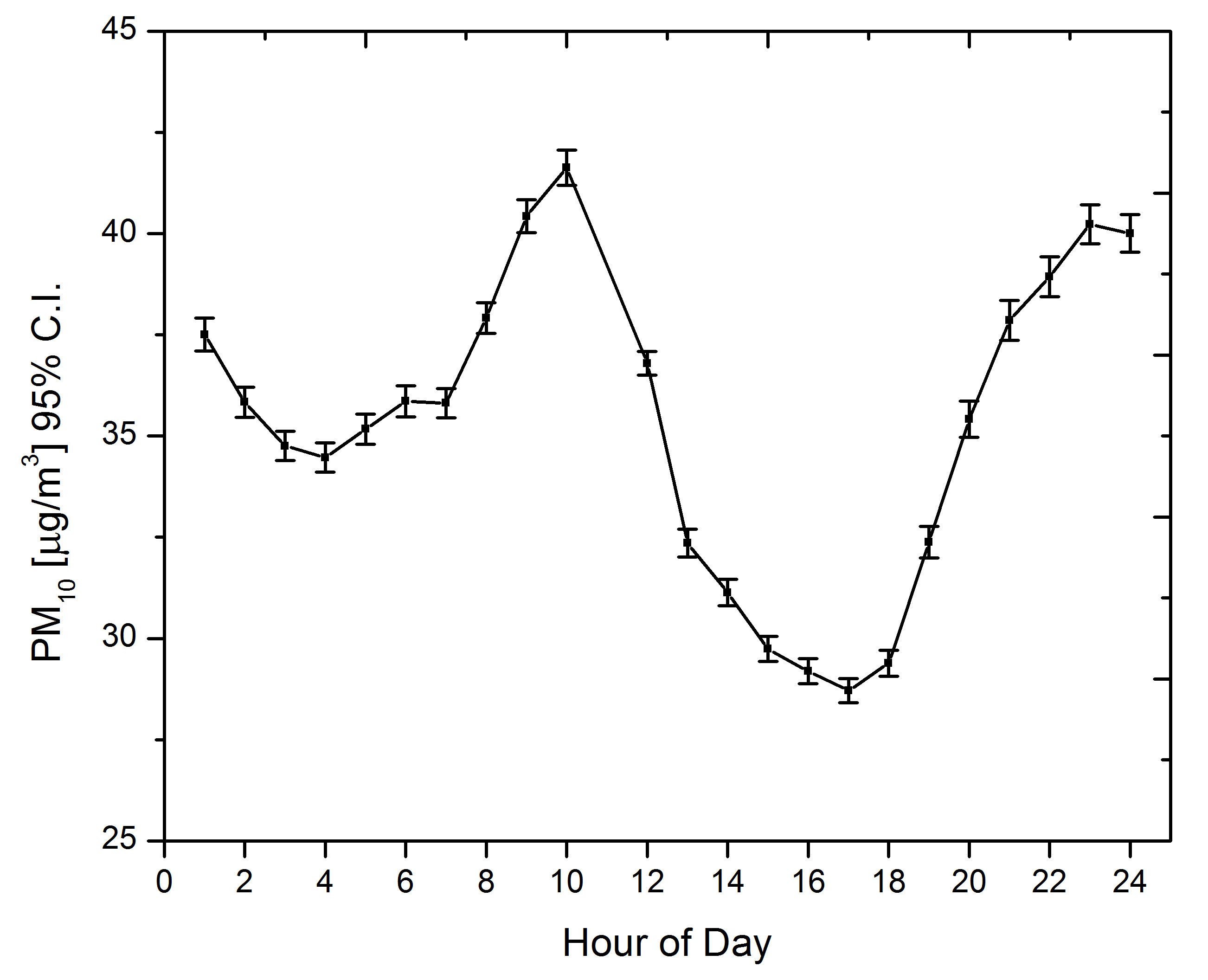 | Figure 10. Standard error of mean of PM10 concentration versus hour of day |
|
|
|
5.2. Effect of ambient Temperature (DB)
- A one-way ANOVA applied to the hourly PM10 values of 2010, versus “Dry bulb temperature” gives the results of Table 3.Thus, PM10 concentrations are dependent on ambient temperature levels with high reliability (F=412). Significance is again 0.000
 | Figure 11. Standard error of mean of PM10 concentration versus ambient temperature |
6. Effect of Relative Humidity
- A one-way ANOVA applied to the hourly PM10 values of 2010, versus “Relative Humidity” gives the results of Table 4.Thus, the PM10 concentrations are dependent on the relative humidity with high F (F=561). The strong effect of the relative humidity on the PM10 levels can be explained based on the following factors: (i) high relative humidity is usually associated with low wind speed and temperature inversion episodes, (ii) very low relative humidity is associated with a dry, dusty urban atmosphere and (iii) the operation principle of the specific type of instrument makes it more sensitive at close-to-saturation conditions, which forms the main weak point of the specific type of instrument[19].
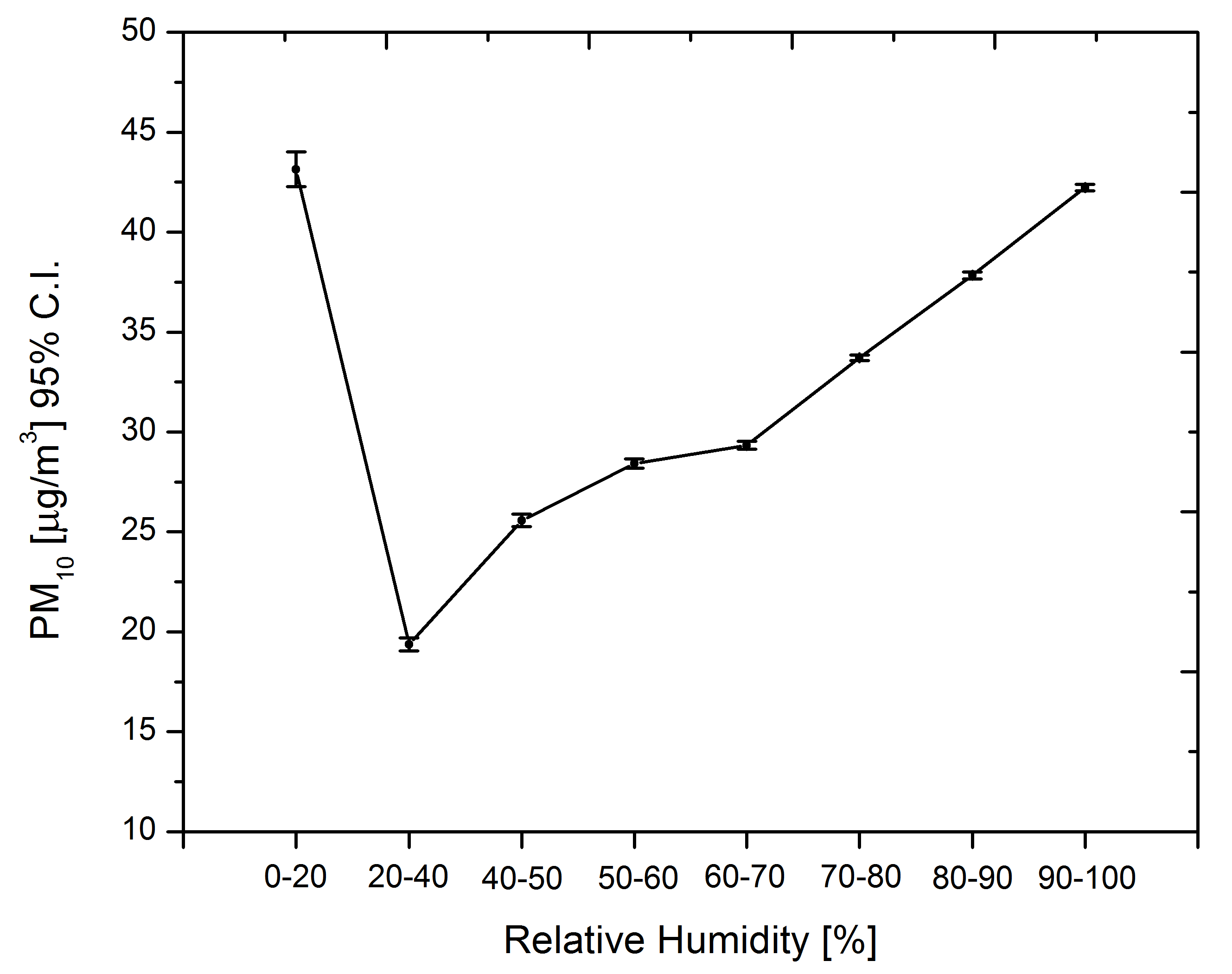 | Figure 12. Standard error of mean of PM10 concentration versus relative humidity |
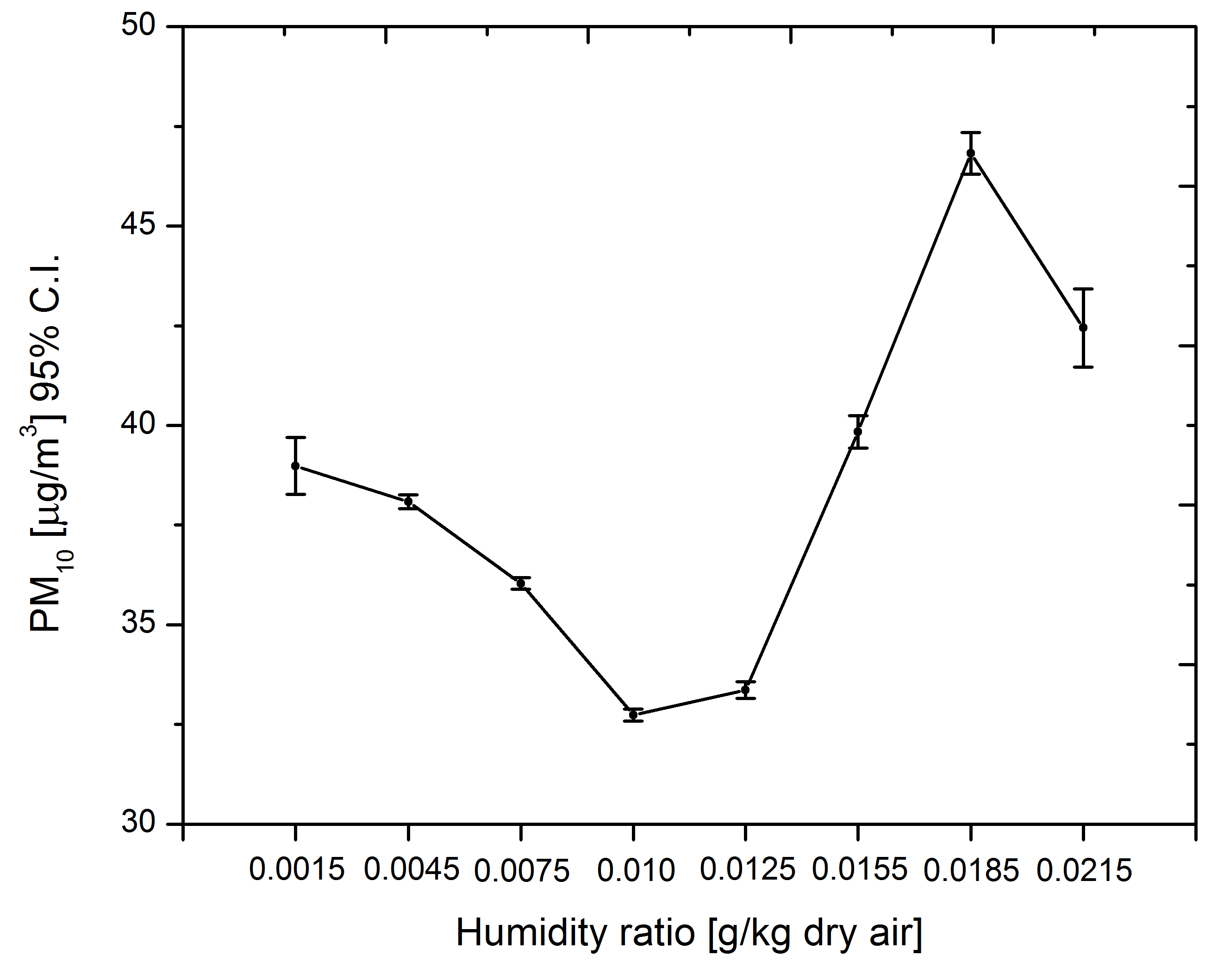 | Figure 13. Standard error of mean of PM10 concentration versus humidity ratio of ambient air |
7. Effect of Wind Direction
- A one-way ANOVA applied to the hourly PM10 values of the year 2010, versus the variable “wind direction” gives the results presented in Table 5.Thus, PM10 concentrations are dependent on the wind direction with a good reliability (F=149 and Significance =0.0). This statistical analysis result agrees with what is known from everyday experience and what is mentioned in the literature.
 | Figure 14. Standard error of mean of PM10 concentration versus wind direction |
8. Effect of Wind Speed
- A one-way ANOVA applied to the hourly PM10 values of the year 2010, versus the variable “wind speed” gives the results presented in Table 6.Apparently, the PM10 concentrations are dependent on the wind speed with a good reliability (F=247 and Significance =0.0). Again, this result agrees with everyday experience and what is reported in the literature.
|
|
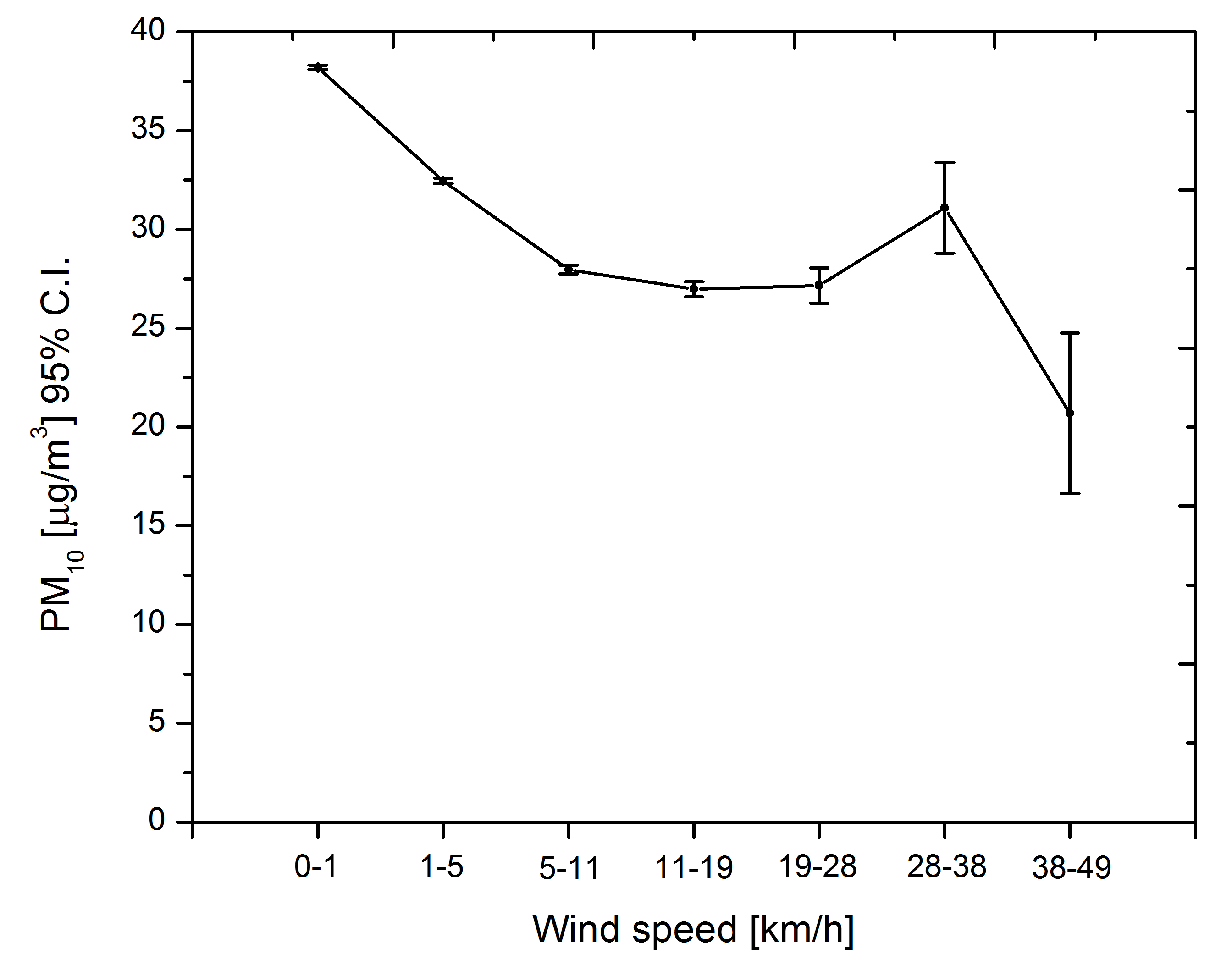 | Figure 15. Standard error of mean of PM10 concentration versus wind speed |
|
9. Conclusions
- After 5 years of systematic PM10 monitoring in Volos with a low-cost, light scattering measurement instrument, we conducted statistical analysis of the PM10 measurements, correlation with the respective meteorological data and comparison with PM10 recordings from the official monitoring station. An overview of the evolution of particulate pollution in Volos was presented, indicating a significant reduction trend for the annual average PM10 levels since 2007, with a tendency to stay below the 40 μg/m3 limit, along with a reduction in the number of days exceeding the 50 μg/m3 threshold, with a tendency to stabilize below 60 days/ year.The effects of the micro-climate of the site on the PM10 concentration levels are clearly visible in the analysis of recordings during the neutral season (May or October), where space heating or -cooling is not necessary.Statistical processing of the 2009-2010 measurement data indicates a negative correlation of PM10 with ambient air temperature during the heating period, and a strong positive correlation with relative humidity at high humidity levels. This last effect is related to an already known instrument sensitivity to high humidity levels. As regards the wind direction, low PM10 concentrations are associated with E to SE winds (coming from the sea) and high concentrations with NW to N winds (coming through the urban area). A negative correlation with wind speed is also observed at low-to-moderate wind speeds.Daily variation of particulate matter concentrations follows well established patterns with peaks at 09:00-10:00 and 23:00-24:00. The results indicate the feasibility of monitoring particulate emissions in urban areas employing low cost equipment, provided that the measured data are routinely checked by standard statistical methods. The operation of an expanded PM10 monitoring network is under way.
Nomenclature
- BAM→ Beta Attenuation Mass measurementDB→ Dry Bulb TemperatureFFT →Fast Fourier TransformFIR→ finite impulse responsePM→ Particulate MatterTEOM→ Tapered Element Oscillating Microbalance
ACKNOWLEDGEMENTS
- It is a pleasure to acknowledge the cooperation of our colleagues and collaborators, Assoc. Prof. Herricos Stapountzis, Dr. George Konstantas, Dipl.-Ing. Dimitris Tziourtzioumis, Dipl.-Ing. Loucas Dimitriades and Assist. Prof. Dimitrios Pandelis, who contributed at various stages of the PM10 monitoring project in Volos in the period 2003-today.
References
| [1] | Chaloulakou, A., et al., Particulate matter and black smoke concentration levels in central Athens, Greece. Environment International 31 (2005) 651– 659, 2005. |
| [2] | GRIVAS, G., et al., SPATIAL AND TEMPORAL VARIATION OF PM10 MASS CONCENTRATIONS WITHIN THE GREATER AREA OF ATHENS, GREECE. Water, Air, and Soil Pollution 158: 357–371, 2004., 2004. |
| [3] | Manoli, E., D. Voutsa, and C. Samara, Chemical characterization and source identification/apportionment of fine and coarse air particles in Thessaloniki, Greece. Atmospheric Environment, 2002. 36(6): p. 949-961. |
| [4] | Voutsa, D., et al., Elemental composition of airborne particulate matter in the multi-impacted urban area of Thessaloniki, Greece. Atmospheric Environment, 2002. 36(28): p. 4453-4462. |
| [5] | N.N., Thermo Andersen FH62C14 - Continuous Ambient Particulate Monitor. Instruction Manual. 2001. |
| [6] | TSI, Model 8520 DUSTTRAK Aerosol Monitor, Operation and Service Manual. 2006, 1980198, Revision R, June 2006. |
| [7] | TSI, Model 8530/8531/8532 DUSTTRAK II Aerosol Monitor, Operation and Service Manual. 2009, P/N 6001893, Revision D, October 2009. |
| [8] | TSI, Model 8530/31/32/33/34 DUSTTRAK II and DRX Aerosol Monitors, Communication Manual. 2009, P/N 6002481, Revision C, October 2009. |
| [9] | Vincent, J.H., Aerosol Sampling Science, Standards, Instrumentation and Applications. 2007, England: John Wiley & Sons. |
| [10] | Husar, R.B. and S.R. Falke, The Relationship Between Aerosol Light Scattering and Fine Mass. 1996, Center for Air Pollution Impact and Trend Analysis:http://capita.wustl.edu/capita/capitareports/bscatfmrelation/BSCATFM.HTML. |
| [11] | Heal, M.R., et al., Intercomparison of five PM10 monitoring devices and the implications for exposure measurement in epidemiological research. J. Environ. Monit., 2000, 2, 455-461, 2000. |
| [12] | Kokhanovsky, A., Aerosol Optics: Light Absorption and Scattering by Particles in the Atmosphere. 2008, Chichester UK: Springer/ Praxis Publishing. |
| [13] | Baynard, T., et al., Key factors influencing the relative humidity dependence of aerosol light scattering. Geophys. Res. Lett., 2006. 33(L06813). |
| [14] | Slavík, M., M. Mudrová, and A. Procházka. Statistical Signal Processing of Environmental Signals. in Proc. of the 5th Int. Conf. Process Control 2002. 2002. |
| [15] | EC, Directive 2008/50/EC of the European Parliament and of the Council of 21 May 2008 on ambient air quality and cleaner air for Europe. 2008, OJ L 152, 11.6.2008. |
| [16] | EC, Council Directive 1999/30/EC of 22 April 1999 relating to limit values for sulphur dioxide, nitrogen dioxide and oxides of nitrogen, particulate matter and lead in ambient air. 1999, OJ L 163, 29.6.1999. |
| [17] | Papanastasiou, D. and D. Melas, Application of PM10′s Statistical Distribution to Air Quality Management—A Case Study in Central Greece. Water Air Soil Pollut (2010) 207:115–122, 2010. |
| [18] | Johansson, C., M. Norman, and L. Gidhagen, Spatial & temporal variations of PM10 and particle number concentrations in urban air. Environ Monit Assess (2007) 127:477–487, 2007. |
| [19] | Kingham, S., et al., Winter comparison of TEOM, MiniVol and DustTrak PM10 monitors in a woodsmoke environment. Atmospheric Environment, 2006. 40(2): p. 338-347. |
| [20] | Zogou, O., Investigation of the effect of the hour of day, month, air temperature, wind direction and velocity and relative humidity on the PM10 recordings of station A, in LTTE#05/2006. 2006, University of Thessaly: Volos. |
| [21] | N.N., PASW® Statistics 18 Core System User’s Guide. 2007, Chicago, IL: SPSS Inc. |
| [22] | Norusis, M.J., PASW Statistics 18 Guide to Data Analysis. 2011: Pearson. |
| [23] | Grivas, G. and A. Chaloulakou, Artificial neural network models for prediction of PM10 hourly concentrations, in the Greater Area of Athens, Greece. Atmospheric Environment 40 (2006) 1216–1229, 2006. |
| [24] | Chaloulakou, A., et al., Measurements of PM10 and PM2.5 particle concentrations in Athens, Greece. Atmospheric Environment 37 (2003) 649–660, 2003. |
 Abstract
Abstract Reference
Reference Full-Text PDF
Full-Text PDF Full-Text HTML
Full-Text HTML